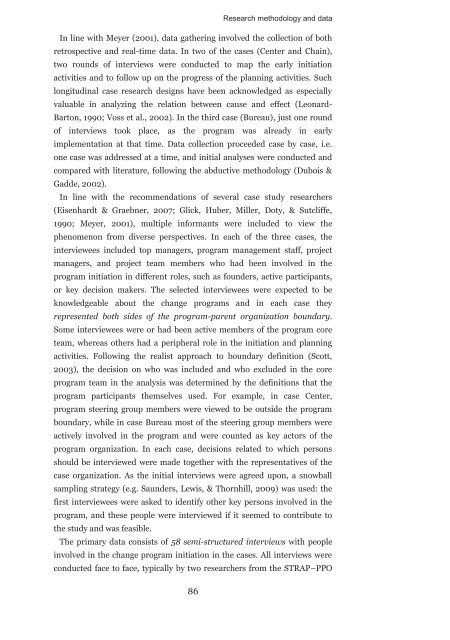Boundary activities and readiness for ... - Projekti-Instituutti
Boundary activities and readiness for ... - Projekti-Instituutti
Boundary activities and readiness for ... - Projekti-Instituutti
Create successful ePaper yourself
Turn your PDF publications into a flip-book with our unique Google optimized e-Paper software.
Research methodology <strong>and</strong> data<br />
In line with Meyer (2001), data gathering involved the collection of both<br />
retrospective <strong>and</strong> real-time data. In two of the cases (Center <strong>and</strong> Chain),<br />
two rounds of interviews were conducted to map the early initiation<br />
<strong>activities</strong> <strong>and</strong> to follow up on the progress of the planning <strong>activities</strong>. Such<br />
longitudinal case research designs have been acknowledged as especially<br />
valuable in analyzing the relation between cause <strong>and</strong> effect (Leonard-<br />
Barton, 1990; Voss et al., 2002). In the third case (Bureau), just one round<br />
of interviews took place, as the program was already in early<br />
implementation at that time. Data collection proceeded case by case, i.e.<br />
one case was addressed at a time, <strong>and</strong> initial analyses were conducted <strong>and</strong><br />
compared with literature, following the abductive methodology (Dubois &<br />
Gadde, 2002).<br />
In line with the recommendations of several case study researchers<br />
(Eisenhardt & Graebner, 2007; Glick, Huber, Miller, Doty, & Sutcliffe,<br />
1990; Meyer, 2001), multiple in<strong>for</strong>mants were included to view the<br />
phenomenon from diverse perspectives. In each of the three cases, the<br />
interviewees included top managers, program management staff, project<br />
managers, <strong>and</strong> project team members who had been involved in the<br />
program initiation in different roles, such as founders, active participants,<br />
or key decision makers. The selected interviewees were expected to be<br />
knowledgeable about the change programs <strong>and</strong> in each case they<br />
represented both sides of the program-parent organization boundary.<br />
Some interviewees were or had been active members of the program core<br />
team, whereas others had a peripheral role in the initiation <strong>and</strong> planning<br />
<strong>activities</strong>. Following the realist approach to boundary definition (Scott,<br />
2003), the decision on who was included <strong>and</strong> who excluded in the core<br />
program team in the analysis was determined by the definitions that the<br />
program participants themselves used. For example, in case Center,<br />
program steering group members were viewed to be outside the program<br />
boundary, while in case Bureau most of the steering group members were<br />
actively involved in the program <strong>and</strong> were counted as key actors of the<br />
program organization. In each case, decisions related to which persons<br />
should be interviewed were made together with the representatives of the<br />
case organization. As the initial interviews were agreed upon, a snowball<br />
sampling strategy (e.g. Saunders, Lewis, & Thornhill, 2009) was used: the<br />
first interviewees were asked to identify other key persons involved in the<br />
program, <strong>and</strong> these people were interviewed if it seemed to contribute to<br />
the study <strong>and</strong> was feasible.<br />
The primary data consists of 58 semi-structured interviews with people<br />
involved in the change program initiation in the cases. All interviews were<br />
conducted face to face, typically by two researchers from the STRAP–PPO<br />
86









